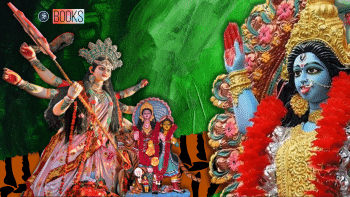Ghosts in Bangla literature and culture

"Bhoot", the Bangla word for ghost, derives from the Sanskrit word Bhūta, referring to living beings and the past. Later, it also came to mean 'disembodied spirit.' Ghost stories carry a special tradition in Bangla literature and the root lies in folklore and rural culture. In the villages of Bengal, the presence of ghosts is a routine occurrence, often considered as household artefact. Most of us, even if we have not met a real ghost, know of somebody among our ancestors or family members who claims to have encountered such a spirit.
Thinking back on my own interest in ghosts, I recall a short poem I read as a child: "Mamdo bhooter shonge hobe gechho petnir biye (Mamdo bhoot will get married to the female spirit of the trees)/ Biye korte jabe petni kanya jatri niye (the female spirit will go the wedding venue with her companions)/ Go bhootera tanbe gari amavasyar raatey (the cow-spirits will draw the cart on the night of dark moon)/ Biye kore firbe petni mamdo bhooter sathe" (the female spirit will return with mamdo bhoot after marriage).
I remember the piece probably because of the way it rhymed and never thought much of it as a child. But looking at it as an adult, I realised how ingenious the poet was. A simple poem composed for children revealed so much about our literature and culture.
The ghostly society has a parallel structure in human society and the similarities are intriguing. The culture of the bridegroom going to the bride's house and bringing her back is reversed in the society of ghosts. Moreover, traditional Hindu weddings are never held on nights of the new moon. So the world of the dead is shown to be quite the opposite of human society.
The popular ghost-stories are deeply embedded in our culture which, in turn, leans largely on food and festivities. Fish and rice are integral to Bengali life. Hence, we come across ghosts or spirits with an appetite for fish and they harass folks returning from the market with fish. Interestingly enough, many of these spirits are often identified with female spirits called 'shakchunni,' who probably as Hindu widows in their lifetime, were deprived of eating fish due to dietary restrictions. Both 'petni' and 'shakchunni' refer to female ghosts, but shakchunni, specifically, is a married female ghost who wears shankha (a traditional bangle made out of a conch), which is a mark of married Hindu women. 'Mechho bhoot' is another lover of fish who accosts late night fishermen or lone people carrying fish. The high-pitched voice of such spirits saying, "maach diye ja" (leave the fish here) can be found in many famous ghost stories.
It is indeed interesting to note the history of different ghosts in our stories. For example, both 'Aleya', or the spirit of the marsh, is said to tempt people with their light and drown them in marshy waters. Some ghosts sport a weakness for sweets, another Bengali gastronomical delight. In most cultures, there is a custom of feeding the departed soul a few days after death. It symbolises a severing between the body and the soul, and there is also a cultural belief that the spirits return to haunt the human world if that ritual was not properly performed. And they return as ghosts to fulfil their unrequited wishes, and most of it involves consuming food and trying to engage in regular human activities.
Many of us may have heard about the fear of bamboo gardens. But did you know about the 'bensho bhoot' or the bamboo spirit? Apparently, if anybody tries to jump over a leaning bamboo, the ghost will throw it back. As a result, the person trying to cross over the bamboo might as well die.
In the areas around the Sundarbans, there are stories of 'begho bhoot'. Begho bhoot does not refer to the spirit of a tiger, but people killed or eaten by tigers. Apparently, these spirits try to scare away villagers from the jungle, and sometimes make them face tigers. 'Kanabhulo' is another such ghost that tries to lure lonely passers-by to alleys and dead-ends and harasses the person by making him go round and round the same route.
'Brahmadatya' is often pictured as a benevolent ghost of a Brahmin who helps our poor woodcutters with magic gifts. Even though he is considered the king of kings among ghosts and all other ghosts respect him, he is rarely seen acting ferociously. Most stories portray the Brahmadatya in a traditional dhoti, smoking hookah on top of some banyan tree.
Ishwar Chandra Vidyasagar can be named as the originator of Bangla ghost stories in literature as he freely translated from the 11th century a Sanskrit collection under the title, Betaal Panchabingsati (meaning, Twenty-five Tales of the Phantom). Betaal, a demonic spirit, is much like a vampire and his story involves King Vikramaditya, a legendary emperor of Ujjaini of Ancient India, entrusted with the task of capturing Betaal and taking him to a Kapalika.
After Vidyasagar, many other well-known writers have also explored ghosts and supernatural activities in their writing. Starting with Rabindranath Tagore and Bibhutibhushan Bandyopadhyay to Sunil Gangopadhyay, Satyajit Ray, Syed Mustafa Siraj, Humayun Ahmed, and Muhammad Zafar Iqbal–ghost stories have been penned by many of our classic and popular writers alike.
Syed Mustafa Siraj and Sunil Gangopadhyay indulged in normalising the presence of ghosts in the everyday life of the rural and semi-urban cultures of Bengal where ghosts are just another category of anomaly. Bibhutibhushan Bandyopadhyay has a variety of supernatural stories, some of which are quite romantic and others sad, frightening, and even hilarious. Satyajit Ray's ghost stories are bone-chilling even though he hardly indulges in elaborating in the actual presence of ghosts. The popular writer Humayun Ahmed had also brought ghost stories to the mainstream audience through a series of paranormal and supernatural stories.
It is quite clear that ghosts occupy an important role in Bangla literature. Interestingly, when it comes to writing on them, not many scholars are interested. "What's there to write about ghosts?" is a remark I have heard from more than one scholar. In spite of some apathy in the scholarly domain, in more recent times, ghost stories have found interpretations through gender theories, which may be indicative of how it is mostly women who have encountered such spirits and had to go through abuse and sexual exploitation in the name of exorcism and such.
The Hindu caste system has also found its way in the portrayal of the spectral community where most of the ghosts, both male and female, are described as dark-skinned–only the Brahmadatya is tall and fair with saint-like feet. Mamdo is even given a skull cap and portrayed with an unkempt beard. Lately, the ghostly figures have been influenced by different Western elements and vampires and other magical creatures are being explored by up-and-coming writers. The repository of Bangla ghost stories is very interesting indeed; it explores the growth of Bengali society and culture through many centuries.
Sohana Manzoor is Associate Professor in the Department of English and Humanities, ULAB.

 For all latest news, follow The Daily Star's Google News channel.
For all latest news, follow The Daily Star's Google News channel. 









Comments